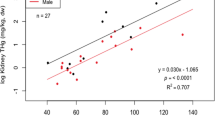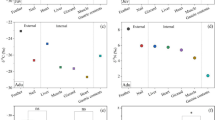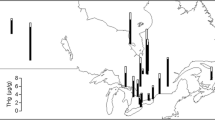Abstract
Mercury (Hg) is a global environmental contaminant that affects ecosystems. It is known to biomagnify through food webs and to bioaccumulate especially in the tissues of top predators. Large-scale comparisons between taxa and geographic areas are needed to reveal critical trends related to Hg contamination and its deleterious effects on wildlife. Yet, the large variety of tissues (keratinized tissues, internal organs, blood) as well as the variability in the units used to express Hg concentrations (either in wet- or dry-tissue weight) limits straightforward comparisons between studies. In the present study, we assessed the moisture content that could influence the total Hg (THg) concentrations measured in several tissues (claws, scutes, total blood, and red blood cells) of three caiman species. We evaluated the moisture content from the different tissues to provide information on THg concentrations in various matrices. Our results show a difference of THg concentrations between the tissues and intra- and interspecific variations of moisture content, with the highest THg values found in keratinized tissues (scute keratinized layers and claws). For the three species, we found positive relationships between body size and THg concentration in keratinized tissues. In the blood, the relationship between body size and THg concentration was species-dependent. Our results emphasize the need for a standardized evaluation of THg concentration and trace elements quantification based on dry weight analytical procedures. In addition, the use of both blood and keratinized tissues offers the possibility to quantify different time scales of THg exposure by non-lethal sampling.





Similar content being viewed by others
Code Availability
Not applicable.
References
Albert C, Renedo M, Bustamante P, Fort J (2019) Using blood and feathers to investigate large-scale Hg contamination in Artic seabirds: a review. Environ Res 177:108588
Alibardi L (2003) Immunocytochemistry and keratinization in the epidermis of crocodilians. Zool Stud 42:346–356
Almli B, Mwase M, Sivertsen T, Musonda MM, Flåøyen A (2005) Hepatic and renal concentrations of 10 trace elements in crocodiles (Crocodylus niloticus) in the Kafue and Luangwa rivers in Zambia. Sci Total Environ 337:75–82
Appelquist H, Asbirk S, Drabaek I (1984) Mercury monitoring: mercury stability in bird feathers. Mar Pollut Bull 15:22–24
Beau F, Bustamante P, Michaud B, Brischoux F (2019) Environmental causes and reproductive correlates of mercury contamination in European pond turtles (Emys orbicularis). Environ Res 172:338–244
Benjamin T, Brasso R, Midway S, Thompson D, Harden LA (2018) Mercury (Hg) concentration in gravid Blanding’s Turtles (Emydoidea blandingii) in Northeastern Illinois. Bull Environ Contam Toxicol 101:295–299
Benoit JM, Gilmour CC, Heyes A, Mason RP, Miller CL (2003) Geochemical and biological controls over methylmercury production and degradation in aquatic ecosystems. Am Chem Soc Symp Ser 835:262–297
Buenfil-Rojas AM, Alvarez-Legorreta T, Cedeño-Vázquez JR (2018) Mercury and metallothioneins in blood fractions and tissues of captive Morelet’s crocodiles in Quintana Roo, Mexico. Chemosphere 199:630–636
Buenfil-Rojas AM, Alvarez-Legorreta T, Cedeño-Vazquez JR, Rendón-von Osten J, González-Jáuregui M (2020) Distribution of metals in tissues of captive and wild Morelet’s crocodiles and the potential of metallothioneins in blood fractions as a biomarker of metal exposure. Chemosphere 244:125551
Burella PM, Odetti LM, Simoniello MF, Poletta GL (2018) Oxidative damage and antioxidant defense in Caiman latirostris (Broad-snouted caiman) exposed in ovo to pesticide formulations. Ecotox Environ Saf 161:437–443
Burger J, Gochfeld M, Rooney AA, Orlando EF, Woodward AR, Guillette LJ Jr (2000) Metals and metalloids in tissues of American Alligators in three Florida lakes. Arch Environ Contam Toxicol 38:501–508
Campbell KR (2003) Ecotoxicology of crocodilians. Appl Herpetol 1:45–163
Campbell JW, Waters MN, Tarter A, Jackson J (2010) Heavy metal and selenium concentrations in liver tissue from wild American alligator (Alligator mississippiensis) liver near Charleston, South Carolina. J Wildl Dis 46:1234–1241
Camus AC, Mitchell MM, Williams JF, Jowett PLH (1998) Elevated lead levels in farmed American alligators Alligator mississippiensis consuming nutria Myocastor coypus meat contaminated by lead bullets. J World Aquacult Soc 3:370–376
Chumchal MM, Rainwater TR, Osborn SC, Roberts AP, Abel MT, Cobb GP, Smith PN, Bailey FC (2011) Mercury speciation and biomagnification in the food web of Caddo Lake, Texas and Louisiana, USA, a subtropical freshwater ecosystem. Environ Toxicol Chem 30:1153–1162
Cook RA, Behler J, Breaitis P (1991) Elevated heavy metal concentrations in captive crocodilians-two cases. In: Proceedings annual meeting of American Association of zoo veterinarians, Greensboro, North Carolina, 1989, pp 151
Day RD, Christopher SJ, Becker PR, Whitakers DW (2005) Monitoring mercury in the Loggerhead Sea Turtle, Caretta caretta. Environ Sci Technol 39:437–446
De Thoisy B, Hrbek T, Farias IP, Vasconcelos WR, Lavergne A (2006) Genetic structure, population dynamics, and conservation of Black caiman (Melanosuchus niger). Biol Conserv 133:474–482
Delany MF, Bell JU, Sundlof SF (1988) Concentrations of contaminants in muscle of the American Alligator in Florida. J Wildl Dis 24:62–66
Eagles-Smith CA, Silbergeld EK, Basu N, Bustamante P, Diaz-Barriga F, Hopkins WA, Kidd KA, Nyland JF (2018) Modulators of mercury risk to wildlife and humans in the context of rapid global change. Ambio 47:170–197
Eggins S, Schneider L, Krikowa F, Vogt RC, Silveira RD, Maher W (2015) Mercury concentrations in different tissues of turtle and caiman species from Rio Purus, Amazonas, Brazil. Environ Toxicol Chem 34:2771–2781
Elsey RM, Lance VA, Campbell L (1999) Mercury levels in Alligator Meat in South Louisiana. Bull Environ Contam Toxicol 63:598–603
Ericksen JA, Gustin MS, Schorran DE, Johnson DW, Lindberg SE, Coleman JS (2003) Accumulation of atmospheric mercury in forest foliage. Atmos Environ 37:1613–1622
Fitzgerald WF, Lamborg CH, Hammerschmidt CR (2007) Marine biogeochemical cycling of mercury. Chem Rev 107:641–662
Guillette LJ Jr, Gross TS, Masson GR, Matter JM, Percival HF, Woodward AR (1994) Developmental abnormalities if the gonad and abnormal sex hormone concentration in juvenile alligator from contaminated and control lakes in Florida. Environ Health Perspect 102:680–688
Guillette LJ Jr, Crain DA, Gunderson MP, Kools SAE, Milnes MR, Orlando EF, Rooney AA, Woodward AR (2000) Alligators and endocrine disrupting contaminants: a current perspective. Am Zool 40:438–452
Harrell FE Jr (2015) Regression modeling strategies: with applications to linear models, logistic regression, and survival analysis, 2nd edn. Springer, New York
Horai S, Itai T, Noguchi T, Yasuda Y, Adachi H, Hyobu Y, Riyadi A, Boggs ASP, Lowers R, Guillette LJ Jr, Tanabe S (2014) Concentrations of trace elements in American alligators (Alligator mississippiensis) from Florida, USA. Chemosphere 108:159–167
Hsu-Kim H, Eckley CS, Achá D, Feng X, Gilmour CC, Jonsson S, Mitchell CP (2018) Challenges and opportunities for managing aquatic mercury pollution in altered landscapes. Ambio 47:141–169
Jagoe CH, Arnold-Hill B, Yanochko GM, Winger PV, Brisbin IL Jr (1998) Mercury in alligators (Alligator mississippiensis) in the southeastern United States. Sci Total Environ 213:255–262
Jensen S, Jernelöv A (1969) Biological methylation of mercury in aquatic organisms. Nature 223:753–754
Lawson AJ, Moore CT, Rainwater TR, Nilsen FM, Wilkinson PM, Lowers RH, Guillette LJ Jr, McFadden KW, Jodice PGR (2020) Nonlinear patterns in mercury bioaccumulation in American alligators are a function of predicted age. Sci Total Environ 707:135103
Lázaro WL, de Oliveira RF, dos Santos-Filho M, da Silva CJ, Ignácio ÁR, Díez S (2015) Non-lethal sampling for mercury evaluation in crocodilians. Chemosphere 138:25–32
Lemaire J, Bustamante P, Olivier A, Lourdais O, Michaud B, Boissinot A, Galán P, Brischoux F (2018) Determinants of mercury contamination in viperine snakes, Natrix maura, in Western Europe. Sci Total Environ 635:20–25
Lemaire J, Bustamante P, Marquis O, Caut S, Brischoux F (2021a) Influence of sex, size and trophic level on blood Hg concentrations in Black caiman, Melanosuchus niger (Spix, 1825) in French Guiana. Chemosphere 262:127819
Lemaire J, Marquis O, Bustamante P, Mangione R, Brischoux F (2021b) I got it from my mother: Inter-nest variation of mercury concentration in neonate Smooth-fronted Caiman (Paleosuchus trigonatus) suggest maternal transfer and possible phenotypical effects. Environ Res 194:110494
Machkour-M’Rabet S, Hénaut Y, Charruau P, Gevrey M, Winterton P, Legal L (2009) Between introgression events and fragmentation, islands are the last refuge for American crocodile in Caribbean Mexico. Mar Biol 156:1321–1333
Manolis S, Webb G, Briton A (2002) Crocodilians and other reptiles: bioindicators of pollution. In the Finnis River. In: Markich SJ, Jeffree RA (eds) A natural laboratory of Moning impact-past, present and future. Australian Nuclear Science and Technology Organisation (ANSTO), Clayton, pp 65–69
Marrugo-Negrete J, Durango-Hernández J, Calao-Ramos C, Urango-Cárdenas I, Díez S (2019) Mercury levels and genotoxic effect in caimans from tropical ecosystems impacted by gold mining. Sci Total Environ 664:899–907
Nilsen FM, Dorsey JE, Lowers RH, Guillette LJ Jr, Long SE, Bowden JA, Schock TB (2017a) Evaluating mercury concentration and body condition in American alligators (Alligator mississippiensis) at Merritt Island National Wildlife Refuge (MINWR), Florida. Sci Total Environ 607–608:1056–1065
Nilsen FM, Kassim BL, Delaney JP, Lange TR, Brunell AM, Guillette LJ Jr, Long SE, Schock TB (2017b) Trace element biodistribution in the American alligator (Alligator mississippiensis). Chemosphere 181:343–351
Nilsen FM, Bowden JA, Rainwater TR, Brunell AM, Kassim BL, Wilkinson PM, Guillette LJ Jr, Long SE, Schock TB (2019) Examining toxic trace element exposure in American alligators. Environ Int 128:324–334
Pacheco-Sierra G, Gompert Z, Dominguez-Laso J, Vazquez-Dominguez E (2016) Genetic and morphological evidence of a geographically widespread hybrid zone between two crocodile species, Crocodylus acutus and Crocodylus moreletii. Mol Ecol 25:3484–3498
R Core Team (2013). R: A language and environment for statistical computing. R foundation for statistical computing, Vienna, Austria. http://www.R-project.org/.
Rainwater TR, Wu TH, Finger AG, Cañas JE, Yu L, Reynolds KD, Coimbatore G, Barr B, Platt SG, Cobb GP, Anderson TA, McMurry ST (2007) Metals and organochlorine pesticides in caudal scutes of crocodiles from Belize and Costa Rica. Sci Total Environ 373:146–156
Richardson KC, Weeb GJW, Manolis SC (2002) Crocodiles: inside out: a guide to the crocodilians and their functional morphology. Surrey Beatty & Sons, Australia, pp 1–172
Rivera SJ, Pacheco LF, Achá D, Molina CI, Miranda-Chumacero G (2016) Low total mercury in Caiman yacare (Alligatoridae) as compared to carnivorous, and non-carnivorous fish consumed by Amazonian indigenous communities. Environ Pollut 218:233–371
Rumbold DG, Fink LE, Laine KA, Niemczyk SL, Chandrasekhar T, Wankel SD, Kendall C (2002) Levels of mercury in alligators (Alligator mississippiensis) collected along a transect through the Florida Everglades. Sci Total Environ 297:239–252
Santos X, Navarro S, Campos JC, Sanpera C, Brito JC (2018) Stable isotopes uncover trophic ecology of the West African crocodile (Crocodylus suchus). J Arid Environ 148:6–13
Scheuhammer AM, Sandheinrich MB (2007) Recent advances in the toxicology of methylmercury in wildlife. Ecotoxicology 17:67–68
Schneider L, Peleja RP, Kluczkovski A Jr, Freire GM, Marioni B, Vogt RC, Da Silveira R (2012) Mercury concentration in the spectacled caiman and black caiman (Alligatoridae) of the Amazon: implications for human health. Arch Environ Contam Toxicol 63:270–279
Schneider L, Eggins S, Maher W, Vogt RC, Krikowa F, Kinsley L, Eggins SM, Da Silveira R (2015) An evaluation of the use of reptile dermal scutes as a non-invasive method to monitor mercury concentrations in the environment. Chemosphere 119:163–170
Selin NE (2009) Global biogeochemical cycling of mercury: a review. Annu Rev Environ Resour 34:43–63
Siroski PA, Poletta GL, Latorre MA, Merchant ME, Ortega HH, Mudry MD (2016) Immunotoxicity of commercial-mixed glyphosate in broad snouted caiman (Caiman latirostris). Chem Biol Interact 244:64–70
Somaweera R, Nifong J, Rosenblatt A, Brien ML, Combrink X, Elsey RM, Grigg G, Magnusson WE, Mazzotti FJ, Pearcy A, Platt SG, Shirley MH, Tellez M, Van der Ploeg J, Webb G, Whitaker R, Webber BL (2020) The ecological importance of crocodylians: towards evidence-based justification for their conservation. Biol Rev 95:936–959
Treu G, Krone O, Unnsteinsdóttir ER, Greenwood AD, Czirják GÁ (2018) Correlations between hair and tissue mercury concentrations in Icelandic arctic foxes (Vulpes lagopus). Sci Total Environ 619–620:1589–1598
Trillanes CE, Pérez-Jiménez JC, Rosíles-Martínez R, González-Jáuregui M (2014) Metals in Caudal Scutes of Morelet’s Crocodile (Crocodylus moreletii) from the Southern Gulf of Mexico. Bull Environ Contam Toxicol 93:423–428
Vieira LM, da Nunes VS, do Amaral MCA, Oliveira AC, Hauser-Davis RA, Campos RC (2011) Mercury and methyl mercury ratios in caimans (Caiman crocodilus yacare) from the Pantanal areas, Brazil. J Environ Monit 13:280–287
Yanochko G, Jagoe C, Brisbin L Jr (1997) Tissue mercury concentrations in alligators (Alligator mississippiensis) from the Florida Everglades and the Savannah River site, Carolina. Arch Environ Contam Toxicol 32:323–328
Acknowledgments
The authors are grateful to the authorities of Conseil Scientifique Régional du Patrimoine Naturel (CSRPN) and La Direction Générale des Territoires et de la Mer de Guyane (DGTM), which authorized our fieldwork. They also thank the teams of “Réserve Naturelle des Nouragues,” “Réserve Naturelle du Mont-Grand Matoury,” “Réserve Naturelle Trésor,” “Réserve Naturelle de la Trinité,” “Réserve Naturelle de Kaw-Roura,” “Pripis de Yiyi,” the Conservatoire du Littoral, F. Starace, T. LePape, F. Beau, L. Beau and P. Gaucher for their help in the field, and E. Courtois, M. Dewynter, and Q. Martinez for providing samples. This work was supported by the Office de l’Eau de Guyane; the Office Française pour la Biodiversité, the Direction Générale des Territoires et de la Mer de Guyane, the Parc Zoologique de Paris, the Fondation d’entreprise Hermès and the CNRS. Thanks to C. Churlaud and M. Brault-Favrou from the “Plateforme Analyses Elémentaires” of LIENSs for their assistance during mercury analyses. The Institut Universitaire de France (IUF) is acknowledged for its support to P. Bustamante as a Senior Member. Thanks to the Nouragues Research Field Station (managed by CNRS) which benefits from “Investissement d’Avenir” grant managed by Agence Nationale de la Recherche (AnaEE France ANR-11-INBS-0001; Labex CEBA ANR-10-LABX-25-01), and its team for assistance in the field.
Funding
Not applicable.
Author information
Authors and Affiliations
Contributions
JL, FB, OM, RM, PB conceived and designed experiments. JL, FB performed statistical analysis. JL performed chemical analysis. JL, FB, OM, RM, PB wrote the manuscript.
Corresponding author
Ethics declarations
Conflict of interest
The authors have no competing interests to declare.
Ethics Approval
Permission to capture individuals, draw blood and sample claws and scutes was granted by the French authorities (Direction Régionale des Territoires et de la Mer) after evaluation by the CSRPN, the regional scientific committee (Permit: R03-2016–06-21–010; R03-2019–01-09–001; R03-2019–10-24–007, www.guyane.developpement-durable.gouv.fr)
Availability of Data and Materials
Data are available from the corresponding author (jeremy.lemaire@univ-lr.fr).
Rights and permissions
About this article
Cite this article
Lemaire, J., Brischoux, F., Marquis, O. et al. Variation of Total Mercury Concentrations in Different Tissues of Three Neotropical Caimans: Implications for Minimally Invasive Biomonitoring. Arch Environ Contam Toxicol 81, 15–24 (2021). https://doi.org/10.1007/s00244-021-00846-y
Received:
Accepted:
Published:
Issue Date:
DOI: https://doi.org/10.1007/s00244-021-00846-y




